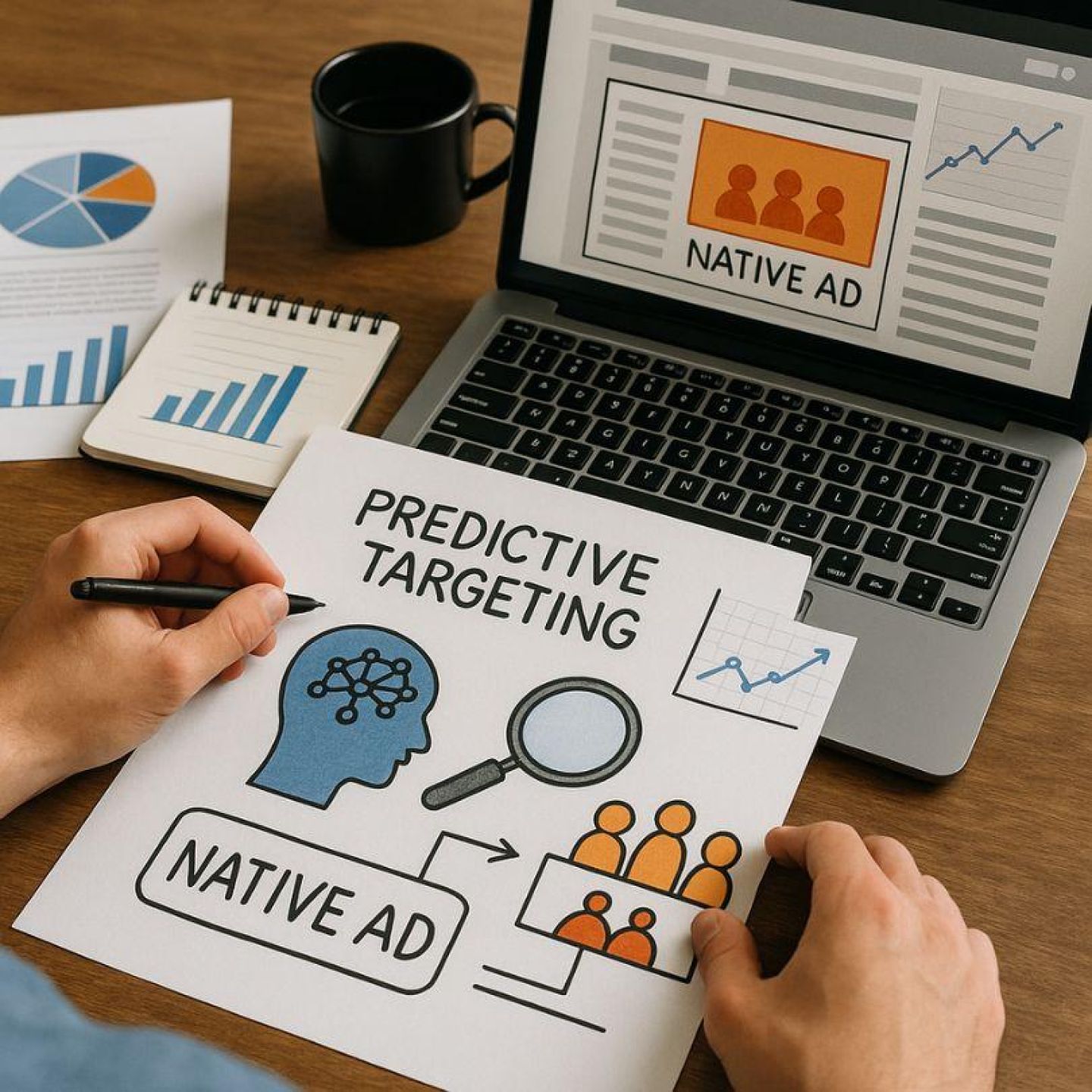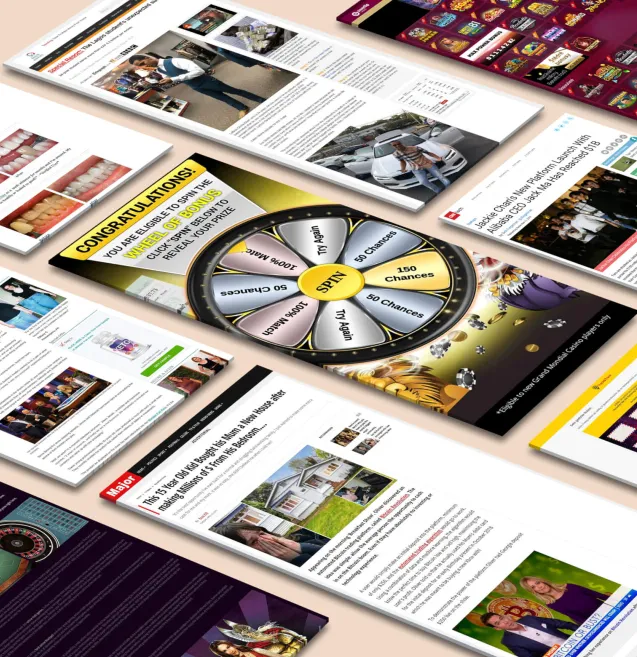
Our spy tools monitor millions of native ads from over 60+ countries and thousands of publishers.
Get StartedThe Power of Predictive Targeting in Native Ads is reshaping how brands connect with consumers in digital spaces. Traditional advertising methods cast wide nets, hoping to catch interested buyers. Predictive targeting in native ads flips this approach entirely—it anticipates what you'll want before you even search for it.
At its core, AI predictive advertising analyzes patterns in user behavior, purchase history, and engagement signals to forecast future actions. This technology transforms native advertising from a passive placement strategy into an active, intelligent system that delivers the right message to the right person at precisely the right moment.
Data-driven native advertising powered by machine learning doesn't just improve campaign performance—it fundamentally changes the game. You're no longer guessing which audience segments might convert. Instead, AI models predict conversion likelihood, customer lifetime value, and optimal engagement timing with remarkable accuracy. This shift from reactive to proactive advertising represents the most significant advancement in digital marketing strategy in recent years.
Predictive targeting operates on a fundamentally different principle than conventional advertising methods. At its core, this approach analyzes first-party data—information collected directly from your customers through interactions with your website, app, or other owned channels—to identify behavioral patterns in advertising that signal future actions.
The mechanism works through continuous data collection and analysis. When users interact with your content, every click, scroll, time spent on page, and conversion creates a data point. Machine learning algorithms process these signals to build comprehensive user profiles that predict likelihood of engagement, purchase intent, and optimal timing for ad delivery.
Traditional demographic targeting relies on broad categories: age, gender, location, income brackets. You're essentially making educated guesses based on who someone is rather than what they're likely to do. Cookie-based methods track past behavior but struggle to anticipate future actions or adapt to changing user preferences.
Predictive audience targeting flips this script entirely:
The AI-driven methodology excels at native ad optimization with AI by processing thousands of variables simultaneously—something impossible with manual segmentation. These algorithms identify non-obvious correlations between user behaviors and conversion outcomes, creating audience segments based on predictive likelihood rather than static characteristics.
First-party data becomes particularly powerful in this context. You're not relying on third-party cookies that provide limited, often outdated information. Instead, you're leveraging direct relationships with your audience to build accurate predictive models that respect privacy while delivering personalization.
The power of predictive targeting lies in sophisticated models that transform raw data into actionable insights. These models work behind the scenes to identify patterns and predict behaviors that traditional analytics would miss.
Propensity modeling stands as the cornerstone of predictive targeting in native ads. This model calculates the likelihood of a user taking a specific action—whether that's making a purchase, signing up for a newsletter, or clicking through to your landing page. You can segment audiences based on their propensity scores, directing your highest-value native ad placements toward users most likely to convert. I've seen campaigns achieve 3x higher conversion rates simply by prioritizing high-propensity segments.
Customer lifetime value estimation takes a longer view of your audience relationships. This model predicts the total revenue you can expect from a customer throughout their entire relationship with your brand. You'll allocate your native ad budget more strategically when you know which audience segments will generate the most value over time. High-CLV predictions justify premium native ad placements and more aggressive bidding strategies.
Churn prediction identifies users at risk of disengaging from your brand before they actually leave. This model analyzes behavioral signals like decreased engagement frequency, reduced time on site, or declining purchase values. You can deploy retention-focused native ads to these at-risk segments, offering personalized incentives or content that reignites their interest.
Reorder timing models predict when customers will need to repurchase consumable products or renew services. You'll reach users with perfectly timed native ads just as they're entering their natural buying window. A skincare brand using reorder timing can serve native ads for moisturizer refills exactly 28 days after the initial purchase, catching customers right when their supply runs low.
These models don't work in isolation—they combine to create a comprehensive view of user behavior. You're not just reacting to what users have done; you're anticipating what they'll do next and positioning your native ads accordingly.
The power of predictive targeting in native ads becomes tangible when you leverage the right technological infrastructure. Several platforms have emerged as leaders in this space, each offering distinct capabilities for implementing AI-driven audience strategies.
Madgicx AI Marketer stands out as a comprehensive solution that automates audience creation and campaign optimization. The platform analyzes your customer data to identify patterns and predict which users are most likely to convert. You can create custom audience segments based on predicted behaviors, allowing you to allocate budget toward high-intent prospects. Madgicx requires a minimum of 1,000 conversions in your historical data to build accurate predictive models, ensuring the AI has sufficient information to identify meaningful patterns.
Facebook Predictive Audiences taps into Meta's vast data ecosystem to forecast user actions. The tool automatically generates lookalike audiences based on users who are predicted to take specific actions, such as making a purchase or subscribing to a service. You need at least 1,000 pixel events from your website within the past 180 days for the system to generate reliable predictions. The platform continuously refines its models as new data flows in, adjusting your targeting parameters in real-time.
Google Smart Bidding integrates predictive analytics directly into your campaign bidding strategy. The system evaluates countless signals at auction time—device type, location, time of day, and browsing behavior—to predict conversion likelihood. You can set target CPA or ROAS goals, and the algorithm automatically adjusts bids to maximize results. Google recommends at least 30 conversions per month for optimal performance, though the system can function with less data.
AdRoll Predictive Audiences and Klaviyo Predictive Analytics round out the toolkit, offering specialized capabilities for retargeting and email marketing integration respectively. These platforms analyze purchase history, browsing patterns, and engagement metrics to identify customers at risk of churning or those ready for upsell opportunities.
However, regardless of the platform used, effective audience targeting remains a crucial element for the success of any native advertising campaign.
Predictive targeting delivers substantial advantages that directly impact your bottom line. Enhanced audience segmentation stands at the forefront of these benefits, allowing you to divide your audience into micro-segments based on predicted behaviors rather than broad demographic categories. This precision translates into click-through rates that often double or triple compared to traditional targeting methods.
The financial impact becomes immediately apparent in your campaign metrics. Advertisers implementing predictive targeting typically see cost-per-conversion reductions ranging from 30% to 50%. You're no longer wasting budget on users unlikely to convert—instead, you're investing in high-intent prospects identified through behavioral forecasting. Improved retention rates emerge naturally from this approach, as your messaging reaches users at optimal moments in their customer journey.
Your campaigns benefit from:
The implementation journey presents distinct challenges you need to address proactively. Data privacy regulations like GDPR and CCPA require careful navigation—you must ensure your predictive models comply with consent requirements and data handling protocols. The shift away from third-party cookies demands robust first-party data collection strategies, which take time to develop.
Model accuracy poses another significant hurdle. Your predictive algorithms need substantial historical data to function effectively—most platforms require at least 1,000 past conversions for reliable predictions. Smaller advertisers or those launching new products face a cold-start problem where insufficient data limits model performance.
Technical complexity shouldn't be underestimated either. You'll need team members who understand both marketing strategy and data science principles, or you'll depend heavily on platform automation without fully grasping how decisions are made. Integration challenges between your existing marketing stack and new predictive tools can create implementation delays and require additional technical resources.
A leading fashion e-commerce brand implemented predictive targeting through Madgicx AI Marketer to identify high-intent shoppers. By analyzing browsing patterns and cart abandonment data, the platform created predictive audiences that were 3x more likely to convert. The native ad campaign, which utilized native advertising strategies, delivered personalized product recommendations within lifestyle content, resulting in a 47% increase in conversion rates and a 35% reduction in cost per acquisition.
A meal kit delivery company used propensity modeling to identify subscribers at risk of cancellation. Their native advertising strategy targeted these users with retention-focused content embedded in recipe blogs and cooking websites. The personalized approach included special offers timed precisely when users showed early churn signals. This predictive targeting initiative decreased customer churn by 62% while maintaining a natural, non-intrusive ad experience.
A fintech startup leveraged customer lifetime value estimation to segment audiences for their native ad campaigns. By focusing ad spend on users predicted to have the highest long-term value, they achieved a remarkable 5.2x return on ad spend. The native ads appeared seamlessly within financial news articles and personal finance blogs, matching both the visual style and editorial tone of the host content.
The future of AI advertising promises unprecedented sophistication in how brands connect with audiences. The Power of Predictive Targeting in Native Ads will expand exponentially as emerging technologies reshape the advertising landscape.
Advanced AI architectures are already transforming predictive capabilities. Generative AI will create hyper-personalized native ad content that adapts in real-time based on individual user contexts. You'll see systems that generate unique headlines, images, and calls-to-action for each impression, moving beyond simple A/B testing into infinite creative variations.
Privacy-first prediction models represent another critical evolution. As third-party cookies disappear completely, federated learning and on-device machine learning will enable accurate predictions without compromising user privacy. These technologies process data locally on users' devices, sending only anonymized insights back to advertisers.
Consumer behavior shifts are accelerating the need for adaptive targeting strategies:
Real-time prediction refinement will operate at millisecond speeds, adjusting targeting parameters based on breaking news, weather patterns, social trends, and competitive actions. You'll leverage predictive systems that automatically shift budgets toward emerging opportunities before competitors recognize them.
The Power of Predictive Targeting in Native Ads represents a fundamental shift in how you connect with your audience. The advertising landscape no longer rewards guesswork—it demands precision, personalization, and proactive engagement.
You need to embrace AI-driven strategies now. The transformative power of predictive targeting lies in its ability to anticipate consumer needs before they materialize, delivering the right message to the right person at exactly the right moment. This isn't just about improving metrics; it's about building meaningful connections that drive sustainable growth.
Data-driven approaches powered by machine learning give you the competitive edge necessary to thrive in an increasingly complex digital ecosystem. Your competitors are already leveraging these technologies to optimize their campaigns, reduce acquisition costs, and maximize return on ad spend.
The question isn't whether you should adopt predictive targeting in your native advertising strategy—it's how quickly you can implement it. Start small, test continuously, and scale what works. Your future success depends on your willingness to evolve with the technology reshaping our industry.
Receive top converting landing pages in your inbox every week from us.
Recently Updated
Native ads can make or break your holiday marketing success. Explore how to evaluate your recent campaigns and identify what worked—or what fell short—with native advertising. Learn key optimization tactics to boost engagement, strengthen audience trust, and increase conversions in future promotions. Ideal for marketers aiming to refine their ad strategies after the holiday rush.
Elena Morales
7 minDec 1, 2025
Quick Read
After Black Friday, shoppers crave more than just deals—they want connection and meaning. Explore how creative storytelling can turn post-sale campaigns into powerful conversion drivers. Learn how to craft narratives that build trust, strengthen brand loyalty, and inspire action beyond discounts. Perfect for marketers aiming to keep engagement high long after the sales frenzy ends.
Marcus Chen
7 minNov 29, 2025
How-To
Year-end campaigns don’t have to suffer from ad fatigue. Explore innovative ways to revive your marketing efforts with fresh creatives, updated messaging, and smarter targeting. Learn how to balance innovation with consistency to keep your audience engaged and conversions steady. Perfect for advertisers looking to finish the year with renewed energy and impactful results.
Rachel Thompson
7 minNov 26, 2025




